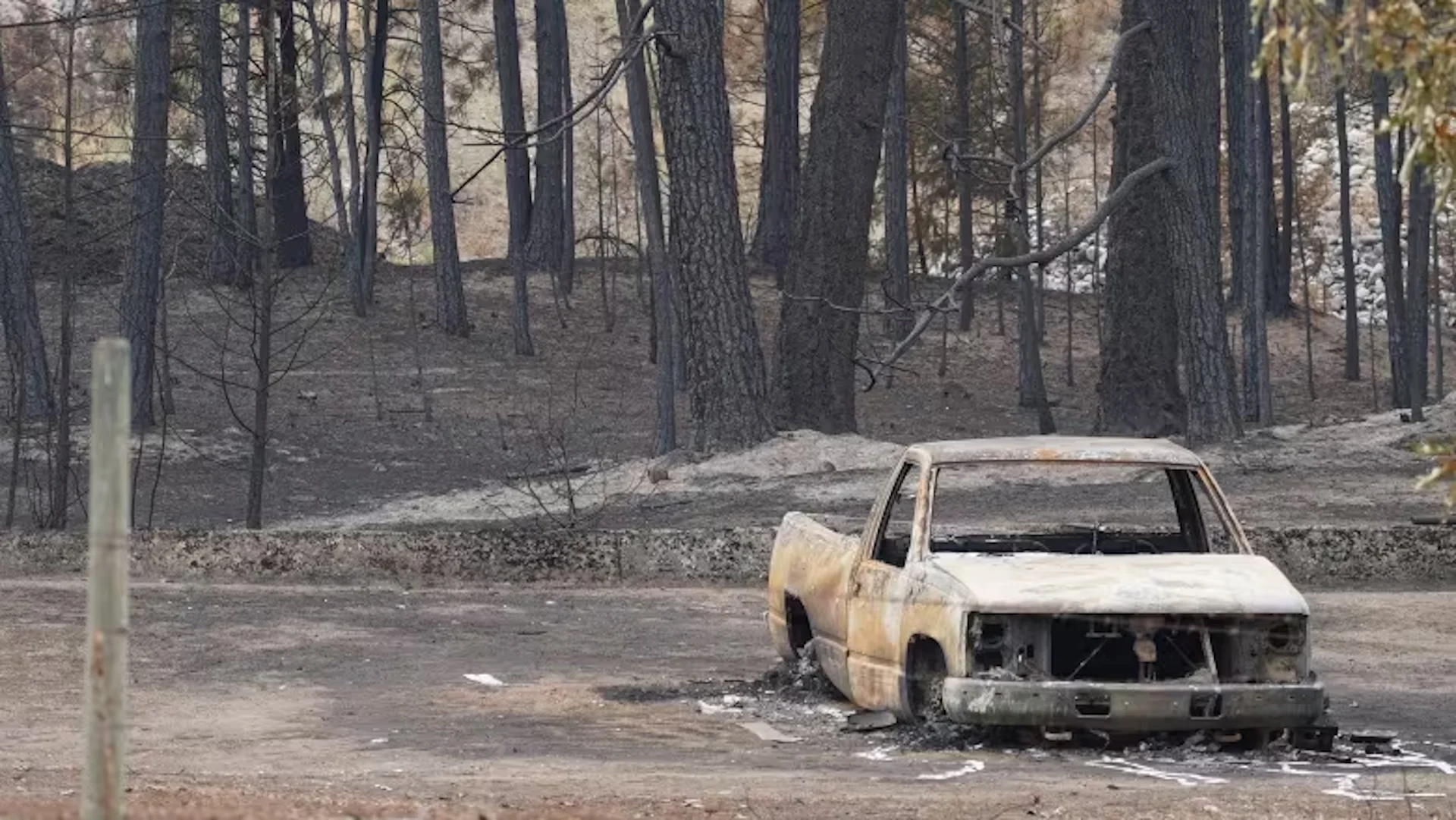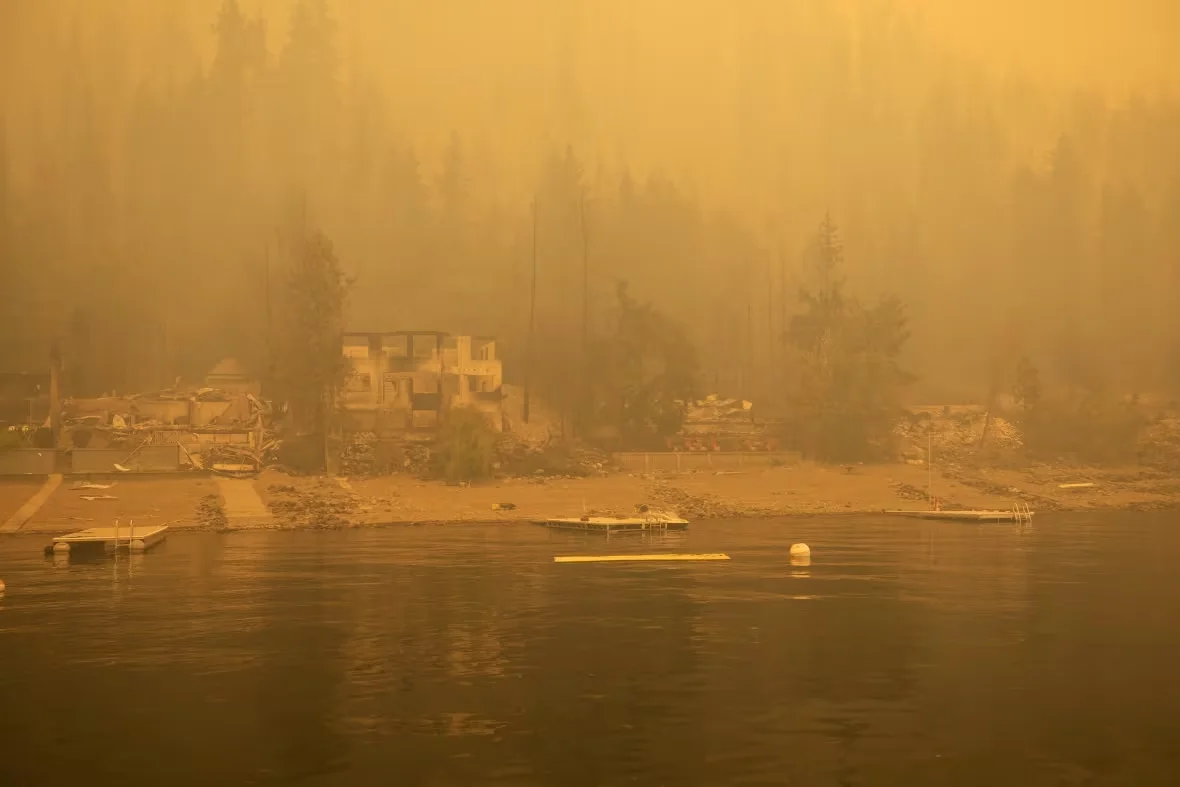
As wildfires still burn, B.C. communities grieve with eye towards rebuilding
Visit The Weather Network's wildfire hub to keep up with the latest on the unprecedented wildfire season across Canada.
Embers rained down on Kukpi7 (Chief) James Tomma and his brothers as they took refuge in a river to escape the raging Bush Creek East wildfire last Friday.
"We had to run to the river ... and the fire was there. It already arrived and it almost immediately leaped the river and started burning on the other side. And we were stuck on by the riverbank," said Tomma, chief of the Skwlāx te Secwepemcúl̓ecw.
MUST SEE: No flight delays for stranded pets reuniting with their owners after evacuations
"It sounded just like a war zone, looked like a war zone ... It wasn't a couple embers, it was showering embers."
The north Shuswap community of around 350 residents had been put on evacuation alert just hours before as the fire converged with the Lower East Adams blaze.
As the Tomma siblings hid under the Squilax Bridge, they could hear the destruction beginning.
"The community exploded and boom, boom, boom, boom, boom. And I knew then, this is my people, they're losing all this," said Tomma, who was rescued by two members of the neighbouring Adams Lake Indian Band by boat.

Kukpi7 James Tomma, right, and brothers Rocky, centre, and Ronnie escaped the Bush Creek East fire by running into a river on Aug. 18, 2023. James and Rocky both lost their homes, which were among the 31 destroyed in the Skwlāx te Secwepemcúl̓ecw community. (Marcella Bernardo/CBC)
More than 31 homes in the community were destroyed by the fire, including Tomma's, and that of his brother, Rocky, who hid with him under the bridge.
But the brothers are taking solace in the fact that everyone made it out alive before the fire ripped through the town.
"I was praying, 'Please let all others get out ... make all other people safe,'" said Rocky. "All were accounted for except for one. And then they got reports that she's OK. Boy, you know, everyone felt that joy."
Now, just one week since that harrowing night, the chief says he is confident that with time and support from other levels of government, the community will be able to rebuild.
Much of the major infrastructure, including the Band office, fire hall, and some community housing is still there, alongside the wellness centre and other townhouses.
"I believe that my band members should be calling home again before snow flies," said Tomma in Kamloops on Friday, vowing not to begin rebuilding his own home until other members were sheltered once again.

Glenmore Road in Kelowna, B.C., is pictured on Aug. 25, 2023. Wildfires burned two properties along the road earlier this week. The full extent of wildfire damage isn't always visible under the rubble, and it takes time for officials to properly inform residents whether their homes are gone or safe. (Tom Popyk/CBC)
But how and when the First Nation will rebuild is still uncertain, and the same questions remain for several other communities devastated by wildfires across B.C. as emergency officials continue to investigate and assess the damage.
SEE ALSO: N.W.T. announces support for wildfire evacuees, urge for more federal help
Fires have decimated street signs, downed power lines and razed key landmarks that can make it difficult for fire officials to identify and report every individual property that has been impacted across the Central Okanagan and in the Shuswap region northeast of Kamloops.
It's an unbearable wait for many to know if their home was among the 131 destroyed in the north Shuswap, or among at least 181 flattened by the Grouse fire complex in the Kelowna area.
The full extent of the damage isn't always visible under the rubble, and it takes time for officials to properly inform residents their homes are gone or safe.
Tomma said misinformation about his home being safe, which was corrected soon after, felt like losing his home twice, while telling other members their homes were gone was "heartbreaking."
And as flames have receded in some areas, officials say it takes time to ensure an area is safe for people to return to, before evacuation orders can be lifted.
Even though several evacuation orders have lifted in the interior, including in Kelowna, West Kelowna and Sorrento, that doesn't mean the areas are habitable.
B.C. Hydro and FortisBC need to do separate evaluations to ensure the electric, water and gas lines are safe, or disabled if they were damaged.
And the Ministry of Transportation and Infrastructure is assessing highways and bridges, noting on Friday that one in north Shuswap is not passable at all right now.
"Lines down on the ground, there's often shutdowns in power that cause rotting food and septic to be not managed ... So there's a massive effort that needs to be undertaken to firm up an area to make it somewhat safe in order for you to go home," said Mike McCulley, a fire information officer with the B.C. Wildfire Service on Friday.
Uncertainty and anxiety
Many residents, however, are anxious to see for themselves, even if they know their homes' fates.
Shuswap residents peppered emergency officials with the Thompson-Nicola Regional District with questions in a Town Hall Friday, pleading to know the fate of their homes, when they might be able to return, and what supports will be available if and when they do.
The meeting came after several protesters attempted to bypass an RCMP blockade on the Trans-Canada Highway near Sorrento on Thursday.

McCulley empathized and urged patience for those eager to return.
"We're desperate to get folks home, just like everybody else is," he said.
Tomma says it could cost up to $50 million to rebuild the homes and buildings the First Nation lost, but it's too soon to know the full extent of the damage to water, electricity and sewage systems.
"We're going to swing for the fences and you know hope that what we get done is gonna be enough for our band members to at the very least get through the near future," he said.
"But the cost is going to be extreme. There's no denying that."
Tomma is thankful no one died, but says rebuilding will be about more than the physical construction of the community.
"Looking on shore and seeing my peoples' homes burning and everything ... there's a difference between house and a home," he said.
"People now, they're just coming to grips with the devastating loss we suffered."
This article was originally published for CBC News on August 26, 2023.










